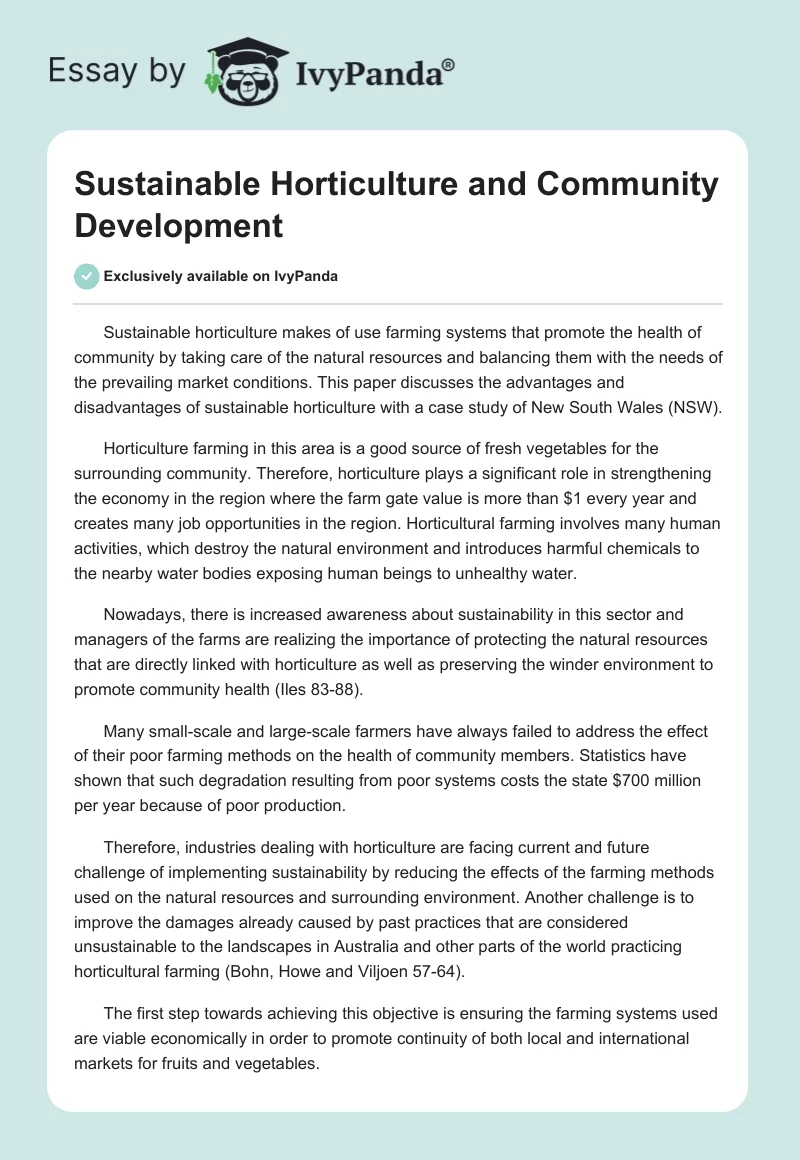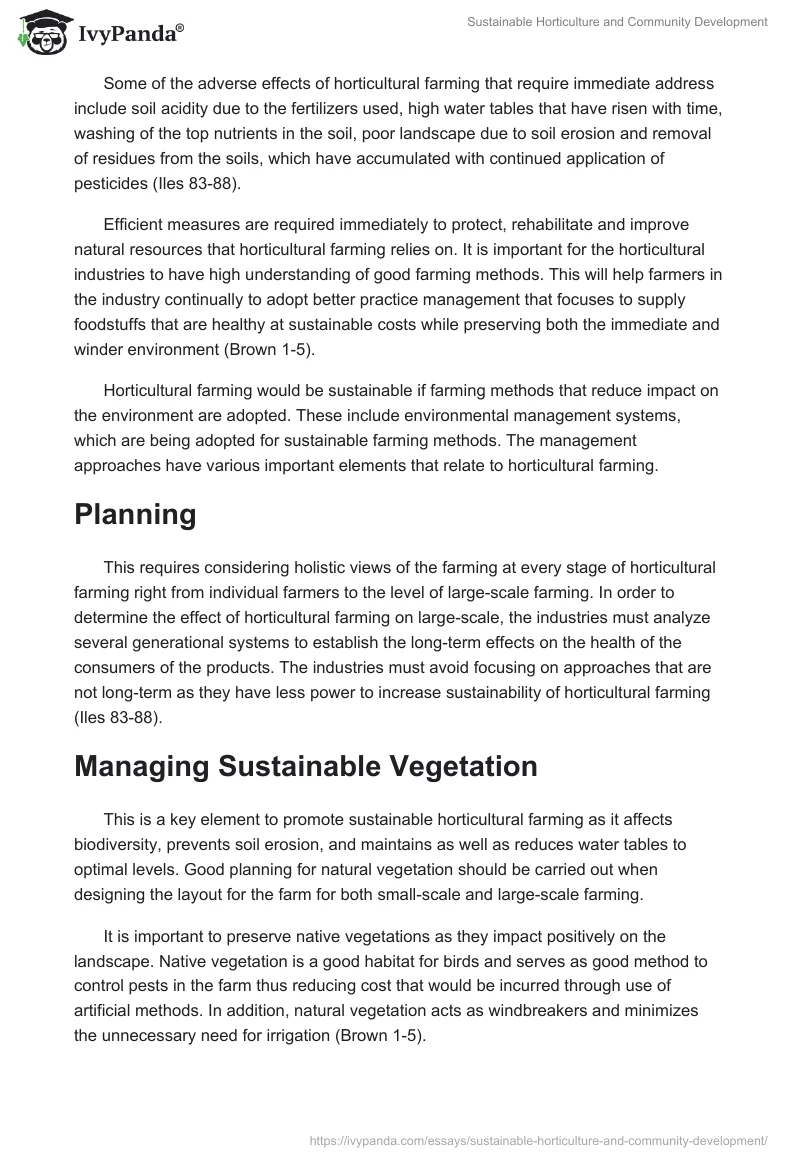Sustainable horticulture makes of use farming systems that promote the health of community by taking care of the natural resources and balancing them with the needs of the prevailing market conditions. This paper discusses the advantages and disadvantages of sustainable horticulture with a case study of New South Wales (NSW).
Horticulture farming in this area is a good source of fresh vegetables for the surrounding community. Therefore, horticulture plays a significant role in strengthening the economy in the region where the farm gate value is more than $1 every year and creates many job opportunities in the region. Horticultural farming involves many human activities, which destroy the natural environment and introduces harmful chemicals to the nearby water bodies exposing human beings to unhealthy water.
Nowadays, there is increased awareness about sustainability in this sector and managers of the farms are realizing the importance of protecting the natural resources that are directly linked with horticulture as well as preserving the winder environment to promote community health (Iles 83-88).
Many small-scale and large-scale farmers have always failed to address the effect of their poor farming methods on the health of community members. Statistics have shown that such degradation resulting from poor systems costs the state $700 million per year because of poor production.
Therefore, industries dealing with horticulture are facing current and future challenge of implementing sustainability by reducing the effects of the farming methods used on the natural resources and surrounding environment. Another challenge is to improve the damages already caused by past practices that are considered unsustainable to the landscapes in Australia and other parts of the world practicing horticultural farming (Bohn, Howe and Viljoen 57-64).
The first step towards achieving this objective is ensuring the farming systems used are viable economically in order to promote continuity of both local and international markets for fruits and vegetables.
Some of the adverse effects of horticultural farming that require immediate address include soil acidity due to the fertilizers used, high water tables that have risen with time, washing of the top nutrients in the soil, poor landscape due to soil erosion and removal of residues from the soils, which have accumulated with continued application of pesticides (Iles 83-88).
Efficient measures are required immediately to protect, rehabilitate and improve natural resources that horticultural farming relies on. It is important for the horticultural industries to have high understanding of good farming methods. This will help farmers in the industry continually to adopt better practice management that focuses to supply foodstuffs that are healthy at sustainable costs while preserving both the immediate and winder environment (Brown 1-5).
Horticultural farming would be sustainable if farming methods that reduce impact on the environment are adopted. These include environmental management systems, which are being adopted for sustainable farming methods. The management approaches have various important elements that relate to horticultural farming.
Planning
This requires considering holistic views of the farming at every stage of horticultural farming right from individual farmers to the level of large-scale farming. In order to determine the effect of horticultural farming on large-scale, the industries must analyze several generational systems to establish the long-term effects on the health of the consumers of the products. The industries must avoid focusing on approaches that are not long-term as they have less power to increase sustainability of horticultural farming (Iles 83-88).
Managing Sustainable Vegetation
This is a key element to promote sustainable horticultural farming as it affects biodiversity, prevents soil erosion, and maintains as well as reduces water tables to optimal levels. Good planning for natural vegetation should be carried out when designing the layout for the farm for both small-scale and large-scale farming.
It is important to preserve native vegetations as they impact positively on the landscape. Native vegetation is a good habitat for birds and serves as good method to control pests in the farm thus reducing cost that would be incurred through use of artificial methods. In addition, natural vegetation acts as windbreakers and minimizes the unnecessary need for irrigation (Brown 1-5).
Managing Sustainable Water
The community health largely depends on healthy water, which is a basic need and therefore the source of water serving the horticultural industries must be healthy. Productivity of the farms also directly depends on healthy water. However, most rivers flowing through horticultural regions have become contaminated with chemicals used in the farms serving the upper regions, which mixes with more chemicals downstream.
This is hazardous for both plants and human consumption. Contamination of water has become an increasing problem as the needs for healthy water has continued to rise over the past decades. In the recent past, the government has introduced reforms to control water pollution by ensuring continuous flow of rivers to enhance ecological processes and have the industries treat their wastewater before releasing it into the water bodies (Bohn, Howe and Viljoen 57-64).
Managing Sustainable Soil
The health of the soil is a key factor to be considered by any farm dealing with horticultural farming, as it is the primary requirement for high and healthy production. The soil must be fertile, structurally good and able to retain the optimum amount of water for the best drainage and sufficient level of water table.
Once the top soil is lost, a considerable time is needed for it to form again and therefore must be retained through a continuous process. The community must be taught on the factors that lead to soil degradation as well as how to identify the soil that has degraded and the effects of such soils to their horticultural productions. Farmers must put measures to prevent soil erosion that is caused by water or wind as well as control the chemicals entering the soil through farm inputs such as fertilizers and pesticides (Barham 49-360).
In order for sustainable horticultural farming to succeed, farmers must have continuous desire to make their farms productive now and in future. The farmers must also be made aware about what the community expects from their farming, which is healthy food and safe environment.
This objective is possible through good planning and reliable management approaches used by modern enterprises (Brown 1-5). Native vegetation requires protection to promote increased biodiversity and secure environment. Water sources and fertile soils must also be appropriately managed, as they are scarce resources that directly affect the horticultural production. Pests and diseases need to be well managed through chemicals.
In addition, natural methods should be emphasized for pest control while maintaining high productivity. More management plans should be developed to help farmers to practice sustainable and profitable farming through introduction of premium products needed in the market (Brown 1-5).
Works Cited
Barham, Elizabeth. “Toward a theory of values-based labeling.” Agriculture and Human Values, 19.4 (2002): 349-360. Print.
Bohn, Katrin, Howe Joe and Viljoen André. New Cities with More Life: Continuous Productive Urban Landscapes: Designing Urban Agriculture for Sustainable Cities, New York: Architectural Press, 2005. Print.
Brown, Martha. “The Alan Chadwick Garden at UCSC.” Journal of the California Garden and Landscape History Society, 13.3 (2010): 1-5. Print.
Iles, Jeremy. (2005). The Social Role of Community Farms and Gardens in The City. In A. Viljoen (Ed.), Continuous Productive Urban Landscapes: Designing Urban Agriculture for Sustainable Cities (83-88.), New York: Architectural Press, 2005. Print.


